Cleveland, OH: The Circle Theatre
- Samantha Gaylor

- Jan 17, 2024
- 5 min read
Address: 10208 Euclid Ave, Cleveland, OH, 44106
Built: 1920
The Circle Theatre Closed: 1959
Status: Demolished (between 1982-1994)
Elvis Dates: February 26, 1955 & October 19, 1955
I Visited On: May 30, 2023
My experience
Unfortunately, I was only in Cleveland for less than a day and only got to snap a picture while I was driving by, so much of an experience, but I’ll be back later, I promise.
History of the theatre & music in Cleveland
The theatre was built in 1920 by Clara A. and Graham Hoffman on property they were leasing at the time, and it was aptly named the Hoffman Theatre.
Seven years later, 1927 brought new management and a new name. The Hoffman became the Circle and was owned by Loew’s Ohio Theatre Inc. When they took over, they updated the facility by installing equipment that enabled the showing of the new “talkie” films.
During the time, the Circle was 1 of 5 theatres in the immediate area and it had a balcony, 1,975 person capacity, a full stage, and dressing rooms. The thriving theatres and shops brought thousands of people to the area and the entertainment/business district quickly became Cleveland’s “second downtown”.

After being closed temporarily, in 1935, the Circle landed in the hands of Max Marmorstein, a real estate operator/property owner with theatre interests tied to Max Lefkowich (a local businessman who’d opened up multiple theatres and hotels in the area) and Henry Greenberger. The theatre was reopened and still maintained the design to host stage productions, as well as film screenings.
In 1936, less than a year after Marmorstein took control of the Circle, the theatre showed a movie titled “Red Salute”. The film is about an accidentally AWOL soldier (Robert Young) who drives a general’s daughter (Barbara Stanwych), a very disliked character and a communist sympathizer, from Mexico to Washington D.C. to see her communist boyfriend. The moving showing attracted protesters from the nearby Western Reserve University and other nearby schools, who were protesting that the film misrepresented the radical youth movement.
During WWII (American involvement 1941-1945), the Circle Theatre transferred hands once again when Emanuel (Mannie) Stutz became manager. In the mid-1950s, Stutz continued showing movies, but mixed in some live country and black music shows. The Hillbilly Jamboree was added on for Saturday nights and was emceed by Tommy Edwards, a local disc jockey for the radio station WERE.

The deejay, Tommy Edwards, was very interested in country music, as well as pop tunes. He was actually a large reason there was so much success seen by 50s artists on the North Coast. Edwards also staged a lot of the early rock hops that took place in Cleveland high schools.
According to Peter Guralnick, author of “Careless Love: The Unmaking of Elvis Presley” and “Last Train to Memphis”, “Edwards had been playing Elvis’ records on WERE since the fall of ‘54 and was an unqualified fan; there was a big market for this music in Cleveland, he assured (Bob) Neal. With all of the southerners who had flocked to town looking for work after the war, in addition to the large black population that occupied the Hough district and a diverse ethnic population, Cleveland was a real music town. The jamboree had unearthed so many hillbillies that Edwards had invited to educate him as to what they wanted to hear.”

*Elvis’ history in the building begins here - Seen below*
In 1959, the theatre was closed for good. Cleveland’s online archives are temporarily closed, so I can’t find out much more, right now.
In 1979, the building appeared dingy, broken down, and waiting for the end. At the time, it was occupied by what was most likely its last occupant, TNT Discount Wigs, before being demolished sometime between 1982-1994 to make way for a medical district. The Cleveland Clinic-Cole Eye Institute stands on the land now.
Timeline
1920: The Hoffman Theatre was built by Clara A. and Graham Hoffman.
1927: The Hoffman was renamed the Circle when the theatre changed hands to Loew’s Ohio Theatres Inc. They installed new equipment to show talkie films.
1935: The theatre was closed temporarily, but was soon bought by Max Marmorstein, a real estate operator/property owner with theatre interests and ties to other businessmen. The Circle reopened after being redesigned to show stage shows, as well as picture shows.
1936: The Circle showed “Red Salute”. It was a new film that showed communist/radical youth groups with one of those communist youths being the main focus of the film. Students from nearby schools and universities protested outside the Circle because the film misrepresented the radical youth movement.
Early 1940s: Marmorstein became the subject in criminal investigations.
1943: All the phones were removed from Marmorstein’s places of business because they were found to be connected with gambling operations.
During WWII (1941-1945 in America): The Circle changed management and Emanuel (Mannie) Stutz was now in charge.
Mid-1950s: Stutz, although still showing movies, mixed in some live country and black music shows. On Saturdays, he invited the Hillbilly Jamboree to play and it was emceed by Tommy Edwards, a local disc jockey.
February 26, 1955: Elvis, Scotty, and Bill performed at 7:30pm and 9:30pm.
October 19, 1955: Elvis, Scotty, and Bill performed at 7:30pm and 10pm.
1959: The Circle closed down and the building ended its known theatre career.
Nov 1979: The Circle’s last known occupant was TNT Discount Wigs.
1982-1994 (exact date unknown at this time): The building was demolished and made way for a medical district
Present: The land where the Circle Theatre once stood, is now the Cleveland Clinic-Cole Eye Institute.

Elvis at the theatre
Elvis’ first performance at the Circle was also his very first performance in Cleveland. The trio (Elvis, Scotty Moore, and Bill Black) had 2 shows at the Circle on Saturday, February 26, 1955, the first at 7:30 PM and the second at 9:30 PM. Bob Neal accompanied the boys that night.

Peter Guralnick stated in “Last Train to Memphis” that “Elvis remained largely unheralded in Cleveland (his records were little more than “turntable hits” there, since Sun’s distribution did not extent effectively that far), but if Bob Neal had been apprehensive about a northern audiences receptivity to this new music, his fears were quickly put to rest. Elvis went over the same as he had throughout the South: the young people went wild, and the older folks covered their mouths. Bill’s souvenir sales were brisk, as he mixed easily with the fans and made change from his money belt, and Tommy Edwardssold a fair number of their records (which they had carried up from Memphis in the truck of Bob’s car) in the lobby.”
Through Edwards, Elvis met Bill Randle, another WERE deejay. Randle was impressed with Bob Neal and with Elvis, especially the Blues feel of some of Elvis’ songs. Randle gave Neal the name of one of his contacts in the song publishing industry who he thought could help Elvis get a tryout for Arthur Godfrey’s Talent Scouts in New York City.
Elvis, Scotty, and Bill were back at the Circle Theatre on October 19, 1955, for 2 more shows (7:30 PM & 10 PM), this time as an addition to another attraction that headlined Roy Acuff & Kitty Wells.
*All above pictures are from the October 19, 1955 show.

Years later, Bill Randle was quoted by Jane Scott, one of, if not the first, legitimate Rock ‘n Roll reporters, in the Cleveland Press Column, describing Elvis Presley as a “...sensational young singer whose style is a combination of hillbilly nasalities, rock-n-roll, Johnnie Ray, and a peculiar sound all his own. The new phenomenon looks like Tony Curtis and drives a pink and black Cadillac. Watch him roar!”
Sources:






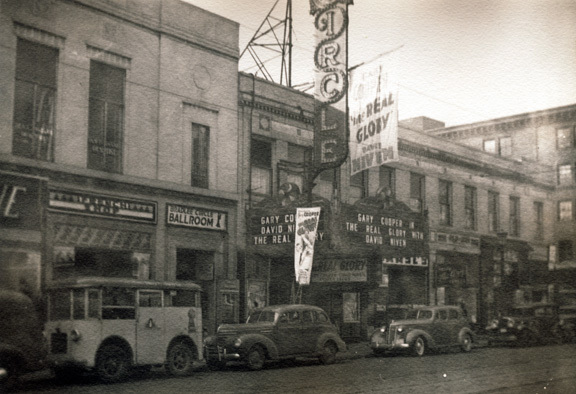

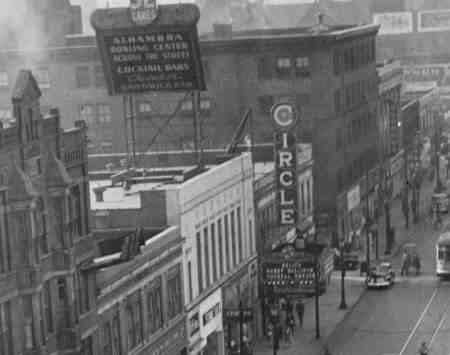



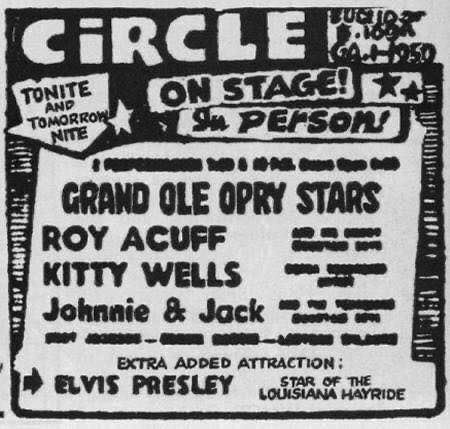

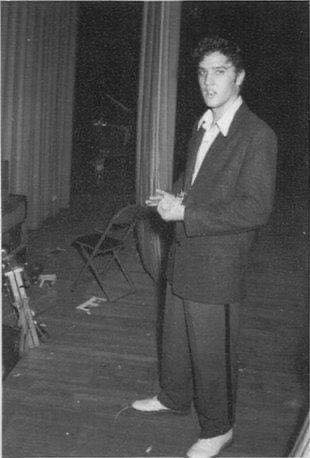

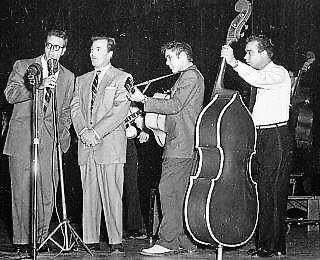










Comments